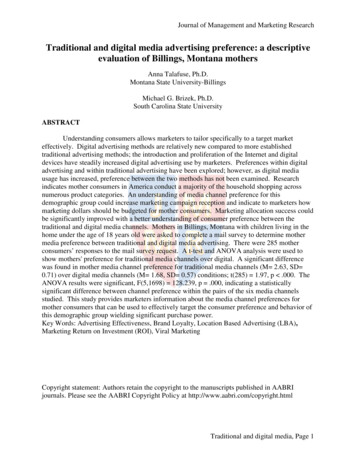
Transcription
Holland et al. BMC Women's Health (2018) EARCH ARTICLEOpen AccessGynaecologists’ and general surgeons’preference for the features of integratedtheatres: a discrete choice experimentTom K. Holland1* , Stephen Morris2 and Alfred Cutner3AbstractBackground: Laparoscopic surgery is progressing rapidly is becoming the normal route for many abdominaloperations, even for major complex surgery. The integrated laparoscopic theatre is a state-of-the-art system inwhich the laparoscopic equipment and multiple flat-screen monitors are permanently installed to be operational ondemand inside the theatre. These expensive systems are being widely adopted, however very little research hasbeen published regarding which features of these systems are desired by the surgeons who use them.The study objective was to assess the strength of preference for key attributes of integrated laparoscopic theatresand to compare these preferences between Gynaecologists and General surgeons.Methods: This was an electronically distributed discrete choice experiment survey of British practicing LaparoscopicGynaecologists and General Surgeons (Through The British Society of Gynaecology Endoscopy and The Associationof Laparoscopic Surgeons of Great Britain and Ireland).An electronic survey was designed and pre-tested. This was then sent to practicing British LaparoscopicGynaecologists and General-Surgeons. There were structured questions regarding the seven key attributes ofintegrated laparoscopic theatres in the standard form for a discrete choice experiment.Results: Questionnaires from 167 respondents were analysed. One hundred three were gynaecologists and 64 weregeneral-surgeons. Adjustable screens for height and position was the most favoured attribute and it is 4.7 timesmore desirable than the next most desirable attribute, which was a wire free floor. The least desirable features werepiped CO2, ceiling-mounted-screens and external-transmission-of-images.Conclusion: Both groups favour adjustable screens for position and height above all the other features. Thesefindings are in contrast with previous research, which showed that when asked to rank the attributes in order,gynaecologists chose ceiling mounted screens first and adjustable screens fourth. When asked to “trade off”attributes in the discrete choice experiment the adjustability of the screens became much more important thanhow the screens were mounted. With new wireless technology the benefits of a fully integrated theatre could bedelivered with floor mounted systems at a considerably reduced cost. This information is important tomanufacturers and purchasers of these systems in order to design cost effective ergonomic theatres that are fit forpurpose.* Correspondence: tomkholland@gmail.com1Department of Women’s Health, University College Hospital, 250 EustonRoad, London NW1 2PB, UKFull list of author information is available at the end of the article The Author(s). 2018 Open Access This article is distributed under the terms of the Creative Commons Attribution 4.0International License (http://creativecommons.org/licenses/by/4.0/), which permits unrestricted use, distribution, andreproduction in any medium, provided you give appropriate credit to the original author(s) and the source, provide a link tothe Creative Commons license, and indicate if changes were made. The Creative Commons Public Domain Dedication o/1.0/) applies to the data made available in this article, unless otherwise stated.
Holland et al. BMC Women's Health (2018) 18:112BackgroundLaparoscopic surgery has advanced due to improvements in both surgical technique and technical innovations. This has placed additional demands on thesurgical environment and theatre design has mirroredthese changing demands [1]. An ergonomic theatre design may improve team performance [2] as surgeonshave been shown to have improved laparoscopic taskperformance when screens are directly ahead and beloweye level, rather than to the side [3]. This ergonomic improvement in operating theatres reduces the risk ofharm to the theatre team and patient, from potentialelectrical, mechanical and biological hazards [2, 4–8].The reduction in theatre nurses’ tasks may reduce physical and mental workload and improve patient safety andjob satisfaction [9]. A stressful theatre environment impairs dexterity and increases the incidence of errors [10].Integrated theatres potentially result in a reduction instress for the operating team [11] and enhanced efficiency during operations [12]. Thus it is likely that thisless stressful theatre environment may improve patientsafety. It has also been suggested that integrated theatresimprove efficiency [13, 14]. However integrated theatresystems are expensive to buy and install as they requirestructural works to support the pendants and install thelinkage between the different elements. Further hiddencosts are surgical downtime during the installationprocess when the theatre is out of action. Average estimated costs are 0.5 million for the purchase and installation of the average high-level system but the costs canvary greatly due to different building structures that arein place before the installation. There are now alternatives to fully integrated laparoscopic theatres with floormounted mobile systems where up to 8 screens can bewirelessly linked and positioned around the operatingroom as required. In addition modern camera heads enable many of the controls of a touch screen to be carriedout directly from the camera head buttons. This createsa realistic alternative to the fully integrated system andmay mean that the benefits of these systems can be delivered more cheaply. For these reasons it is importantto understand which attributes of the currently sold laparoscopic integrated theatres are favoured by the surgeons who work in them.A previous study [15] showed that the attributes oflaparoscopic theatres which gynaecologists rated mosthighly, however, this study did not investigate thestrength of the preference for these features, which isuseful to judge how highly they are valued. In this studywe chose to use a discrete choice experiment (DCE) todetermine the relative importance placed on specific attributes of laparoscopic theatres as this is the best measure of how highly attributes are valued. By askingparticipants to choose between a series of hypotheticalPage 2 of 6options with varying attributes, DCE’s reveal which attributes influence choice behaviour, establish an individual’s willingness to trade-off one attribute againstanother and as a result provide an insight into real-lifedecision making [16, 17]. The aim of this study was toassess the strength of preference for key attributes of integrated laparoscopic theatres and to compare thesepreferences between Gynaecologists and Generalsurgeons.MethodsThe study design and analysis followed current guidelines for conducting DCEs [18]. A pilot questionaire wasconducted with five laparoscopic gynaecological surgeons from within the department and the findings wereused to improve the finalised version of thequestionnaire.Study sampleParticipants were recruited from two specialist societies:The British Society of Gynaecology Endoscopy and TheAssociation of Laparoscopic Surgeons of Great Britainand Ireland. Email invitations were sent out to all of themembers of both societies with a link to the questionnaire on a surveymonkey (San Mateo, California, USA)website. One reminder email was sent to each member.Responses were anonymised but respondents were onlyallowed to respond once from each computer.Ethical approvalAccording to the UK National Health Service Health Research Authority online tool, ethical approval for thisstudy was deemed unnecessary since this study was ahealth professional survey, which did not include invasive procedures, use of medical devices or products,human tissues or patient involvement ionnaire designThe questionnaire comprised 2 sections;1. Demographic questions2. Structured questions about the attributes oflaparoscopic theatres (see Additional file 1).The attributes used in the DCE were as follows:1) Ceiling vs floor mounted screens2) Screens adjustable for height or position vs fixedscreens3) Piped CO2 vs canister CO24) Gas on/off controlled by surgeon (sterile personnel)vs runner (non sterile personnel)
Holland et al. BMC Women's Health (2018) 18:1125) Room lights controlled by surgeon (sterilepersonnel) vs runner (non sterile personnel)6) Wire free floors vs wires on the floors7) External transmission of video vs none.These were selected after previous survey-based research into this area by the authors [15] to identify theattributes of laparoscopic theatres that gynaecologistsrated most highly. The attributes of laparoscopic theatres which gynaecologists rated most highly, in order,were: Ceiling mounted stacks and monitors; More thantwo screens; Surgeon controlling image capture/ videorecording; Screens adjustable for height position andangle but may be floor mounted; Surgeon controllinglaparoscope light; Touch screen control of devices bysurgeon; Surgeon controlling gas flow; Surgeon controlling operating table; Piped (continuous gas flow); Surgeon controls overhead lights; Ability to transmit imagesto another location.The DCE design followed the approach of Street andBurgess [19, 20]. All attributes had two levels – whetherthat feature was present or not. The number of possiblecombinations of attributes and levels were statisticallyreduced from 27 128 to 8 scenarios using an orthogonal fractional main effects design [21] to give a practical number of choices for participants to complete inthe questionnaire. A shift of one level was applied to theinitial eight scenarios to create eight additional scenariosthat were randomly paired to form eight choice sets (seeAdditional file 2 and Methods online). In the questionnaire participants were asked to choose one of the twooptions, A or B; a ‘neither’ option was not offered.Statistical analysisThe DCE preference data were analysed using a conditional logit regression model [22]. We anticipatedpositive ( ) coefficients for all variables, as we expected participants to prefer each feature comparedwith not having it. Effects coding was used for allvariables. To determine the trade-offs participantswere willing to make between test attributes the marginal rates of substitution (MRS) were calculated as aratio of the coefficients of two selected attributes.The MRS allows direct assessment of how much ofone attribute participants are willing to trade for oneunit of another attribute and enables a comparison ofdifferent attributes on a common scale [23]. The datawere analysed for the whole group and for gynaecologists and general surgeons separately. The preferencesof gynaecologists and general surgeons were compared using Wald tests.All statistical analysis was carried out using Stata version 12.0.2 (StataCorp College Station, TX, USA).Page 3 of 6ResultsQuestionnaires from 167 respondents were analysed.One hundred three were gynaecologists (out of 639 invited 16.1%) and 64 were general surgeons (out of 533invited 12.0%). For gynaecologists 66/103 (64.1%) weremale and 37/103 (35.9%) were female and for the generalsurgeons these figures were 57/64 (89.1%) and 7/64(10.9%) respectively. For both groups together thismeans that 123/167 (73.7%) were male and 44/167(26.3%) were female.For gynaecologists 72/103 (69.9%) were Consultantsand 31/103 (30.1%) were Doctors in training and for thegeneral surgeons these figures were 51/64 (79.7%) and13/64 (20.3%) respectively. For both groups together123/167 (73.7%) were Consultants with 44/167 (26.3%)Doctors in training.Respondents were asked how often they carried outlaparoscopic surgery. 81/167 (48.5%) performed majorlaparoscopic surgery every week, 31/167 (18.6%) every 2weeks and 55/167 (32.9) once a month or less.Table 1 shows the results for the conditional logit analysis regression for both Gynaecologists and GeneralSurgeons combined. Adjustable screens for height andposition was the most favoured attribute and it is nearly5 times more desirable than the next most desirable attribute, which was a wire free floor (MRS 1.584/0.335 4.7). The least desirable features were piped CO2, ceiling mounted screens and external transmission of images the presence or absence of which did notsignificantly affect participants decision-making.Table 1 also shows the results for the conditionallogit analysis regression for both Gynaecologists andGeneral Surgeons analysed separately and compared.This shows that the most desirable four features arethe same and in the same order for both groups.General surgeons were statistically significantly morelikely than gynaecologists to value adjustable screensover the other attributes. The MRS is also similar forboth groups (gynaecologists 5.0, general surgeons 4.2). Although there appears to be disagreement between the groups on the order of the least desirable 3features, none of these significantly affecteddecision-making.Table 2 shows the results for the conditional logit analysis regression for male and female participants analysed separately and compared. This shows that maleand female participants agreed on the three most desirable features and in the same order. There were no significant differences when comparing the choices of maleand female participants.There were no statistically significant differences whenconsultants were compared with Doctors in training andwhen more experienced participants were comparedwith less experienced participants.
Holland et al. BMC Women's Health (2018) 18:112Page 4 of 6Table 1 Conditional logit analysis regression results for Whole group n 167 and Gynaecologists and General surgeons analysedseparately and compared. Overall P 0.02Whole group n 167Gynaecologists n 103General surgeons n 64DifferenceaAttributeCoefficient (95% CI)P valueCoefficient (95% CI)P valueCoefficient (95% CI)P valueP valueScreens adjustablefor height and position1.584 (1.397 to 1.772) 0.00011.397 (1.179 to 1.615) 0.00012.046 (1.638 to 2.453) 0.00010.009Wire free floor0.335 (0.170 to 0.500) 0.00010.277 (0.081 to 0.474)0.0060.489 (0.172 to 0.807)0.003NSC02 on/off controlledby sterile personnel0.307 (0.139 to 0.474) 0.00010.247 (0.048 to 0.446)0.0150.477 (0.140 to 0.815)0.006NSRoom lights controlledby sterile personnel0.209 (0.014 to 0.405) 0.00010.176 ( 0.050 to 0.402)0.1280.381 ( 0.044 to 0.805)0.079NSPiped CO20.095 ( 0.072 to 0.262)NS 0.012( 0.211 to 0.187)0.9060.352 ( 0.015 to 0.689)0.04NSScreens ceilingmounted0.082 ( 0.111 to 0.275)NS0.087 ( 0.135 to 0.308)0.4440.092 ( 0.338 to 0.522)0.675NSExternal transmissionof images 0.006 ( 0.206 to 0.194)NS0.021 ( 0.210 to 0.252)0.861 0.033 ( 0.473 to 0.406)0.882NSaDifference between Gynaecologist and general surgeonsTable 3 shows the geographical spread of BSGE responders and BSGE members overall. Chi squared foran 8 2 table of difference between the location of thesurvey responders and the location of all BSGE membersgave Chi-square 8.93, probability P 0.257. This showsthat the geographical variation of the respondents wasrepresentative of the BSGE membership as a whole. Table4 shows an example question in the DCE.DiscussionThis is the first study to use a discrete choice experiment to assess the features of integrated laparoscopictheatres that surgical personnel favour. It is also the firststudy to compare different choices that exist betweengeneral surgeons and gynaecologists regards laparoscopic of-the-art system in which multiple flat-screenmonitors and other laparoscopic equipment are permanently installed to be operational on demand inside thetheatre. This system facilitates versatile positioning ofequipment as they are installed on columns attached toa ceiling-mounted suspension system. All the wiring isconcealed inside the suspension system and led outthrough the ceiling which reduces operating room clutter and improves safety [4, 24]. The CO2 gas, ratherthan utilising small canisters, is piped on demand thusreducing the time needed to change canisters and the resultant loss of a pneumoperitoneum that goes with lossof gass. The surgeon and theatre staff are able to controlthe laparoscopic and theatre room equipment usingtouch screen monitors. This is in contrast to the traditional laparoscopic systems with one, non adjustablescreen which is mounted on top of a floor mountedstack of equipment which can be wheeled into theatre asrequired.Generally there was agreement between general surgeons and gynaecologists with the same four attributesfavoured in the same order. Both groups favour adjustable screens for position and height above all the otherfeatures with general surgeons more strongly favouringthis attribute than gynaecologists. These findings are inTable 2 Conditional logit analysis regression results for Male and Female participants analysed separately and comparedMale participants n 123Female participants n 44DifferenceAttributeCoefficient (95% CI)P valueCoefficient (95% CI)P valueP valueScreens adjustable for heightand position1.61 (1.39 to 1.828) 0.00012.046 (1.638 to 2.453) 0.0001NSWire free floor0.321 (0.124 to 0.517)0.0010.367 (0.053 to 0.682)0.022NSC02 on/off controlled bysterile personnel0.314 (0.114 to 0.515)0.0020.290 ( 0.023 to 0.603)0.07NSRoom lights controlled bysterile personnel0.176 ( 0.048 to 0.401)0.1240.291 ( 0.031 to 0.614)0.076NSPiped CO20.142 ( 0.057 to 0.341)0.162 0.022 ( 0.336 to 0.290)0.886NSScreens ceiling mounted0.086 ( 0.141 to 0.314)0.4570.0676 ( 0.271 to 0.406)0.696NSExternal transmission of images 0.064 ( 0.302 to 0.174)0.600 0.138 ( 0.221 to 0.497)0.452NS
Holland et al. BMC Women's Health (2018) 18:112Page 5 of 6Table 3 Geographical spread of BSGE responders and BSGEmembers overallAreaBSGE respondersBSGE overallWales335London26140South West1362South East England14154Midlands1462North of England22145Scotland330Northern Ireland/ Ireland311Total986393 respondents did not answer this question as it was not a mandatory fieldand 2 responders were from outside the UKcontrast with the findings of our previous study, whichshowed that when asked to rank the attributes in order,gynaecologists chose ceiling mounted screens first andadjustable screens fourth. When asked to “trade off” attributes in the discrete choice experiment the adjustability of the screens became much more important thanhow the screens were mounted.The findings of our study suggest that the main benefitof integrated laparoscopic theatres is the ability to position the screens almost anywhere in the theatres. Dueto wireless technology, floor mounted systems could bedesigned to function in the same way as current integrated theatres. This removes the need for expensivebuilding works and long theatre down time during installation. Thus the modern laparoscopic theatre couldTable 4 Example of a question in the DCEIn order to help improve the quality of the theatre environment forlaparoscopic surgeons it is important to understand which features oflaparoscopic theatres are valued and which are not valued.In the next set of questions you will be asked to choose between twodifferent theatre configurations. Although the options may seemcontrived please try to choose between the options in an honest wayas this will help to evaluate the options.Please choose option A or B.Option A.The screens and stacks are floor mounted.The screens are not adjustable for height, angle or position.The C02 is in canisters.The laparoscopy light, CO2 gas on/ off and room lights are controlledby the non scrubbed nursing staff.There are wires on the floor and there is no external transmission of theimages.Option B.The stacks and screens are ceiling mounted and fully adjustable forheight, angle and position.The CO2 is piped (continuous) and the sterile personnel (surgeon orscrub nurse) can control the laparoscope light, CO2 gas on/off and theoverhead room lights.The floor is wire free and the there is external transmission of video setup.be delivered at a considerably reduced cost. This information is important to manufacturers and purchasers ofthese systems in order to design cost effective ergonomictheatres that are fit for purpose. Thus the advent ofwireless connectivity technology with monitors on slimversatile stands enables the market place to be expandedat a much reduced cost.Strengths and limitations of the studyThis is the first study to use a discrete choice experiment to assess the desirability of the features of integrated laparoscopic theatres. The relatively small samplesize is a limitation of the study. Another limitation ofthe study is that not all responders have regular accessto fully integrated theatres.Further research on this area, especially among a moreinternational cohort and other surgical specialties, wouldbe helpful to improve our understanding of this issue.ConclusionBoth groups favour adjustable screens for position andheight above all the other features. These findings are incontrast with previous research, which showed thatwhen asked to rank the attributes in order, gynaecologists chose ceiling mounted screens first and adjustablescreens fourth. When asked to “trade off” attributes inthe discrete choice experiment the adjustability of thescreens became much more important than how thescreens were mounted. With new wireless technologythe benefits of a fully integrated theatre could be delivered with floor mounted systems at a considerably reduced cost. This information is important tomanufacturers and purchasers of these systems in orderto design cost effective ergonomic theatres that are fitfor purpose.Additional filesAdditional file 1: Full data set as a PDF. (PDF 120 kb)Additional file 2: Full data set as a excel spreadsheet. (XLS 69 kb)AbbreviationsCO2: Carbon dioxide; DCE: Discrete choice experiment; MRS: Marginal ratesof substitutionAcknowledgementsWe would like to acknowledge Mr. Al Windsor for his assistance with therecruitment of the general surgeons to this study.Availability of data and materialsA full data set of results is provided.Authors’ contributionsTKH, AC and SM were involved in the development of the concept, draftingthe questionnaire and writing the manuscript. TKH and SM analysed thedata. All authors read and approved the final manuscript.
Holland et al. BMC Women's Health (2018) 18:112Ethics approval and consent to participateNot applicable. According to the UK National Health Service Health ResearchAuthority online tool, ethical approval for this study was deemedunnecessary since this study was a health professional survey, which did notinclude invasive procedures, use of medical devices or products, humantissues or patient involvement nt to take part was implicit in the fact that they did take part.Competing interestsTom Holland and Stephen Morris have no conflicts of interest or financialties to disclose. Alfred Cutner has received funding and support from Storz,Olympus and Stryker for lectures and education purposes relating tointegrated theatres.Publisher’s NoteSpringer Nature remains neutral with regard to jurisdictional claims inpublished maps and institutional affiliations.Author details1Department of Women’s Health, University College Hospital, 250 EustonRoad, London NW1 2PB, UK. 2Department of Applied Health Research,University College London, Gower Street, London WC1E 6BT, UK.3Department of Women’s Health, University College Hospital, 250 EustonRoad, London NW1 2PB, UK.Received: 2 February 2017 Accepted: 22 May 2018References1. Essex-Lopresti M. Operating theatre design. Lancet. 1999;9157:1007–10.2. Herron DM, Gagner M, Kenyon TL, et al. The minimally invasive surgicalsuite enters the 21st century. Surg Endosc. 2001;15:415–22.3. Hanna GB, Shimi SM, Cuschieri A. Task performance in endoscopic surgeryis influenced by location of the image display. Ann Surg. 1998;227:481.4. Cutner A, Stavroulis A, Zolfaghari N. Risk assessment of the ergonomicaspects of laparoscopic theatre. Gynecol Surg. 2013;10:99–102.5. Berguer R. Surgery and ergonomics. Arch Surg. 1999;134:1011–6.6. Quinn D, Moohan J. The trainees’ pain with laparoscopic surgery: what dotrainees really know about theatre set-up and how this impacts their health.Gynecol Surg. 2015;12:71–6.7. Alleblas CCJ, de Man AM, van den Haak L, et al. Prevalence ofmusculoskeletal disorders among surgeons performing minimally invasivesurgery. Ann Surg. 2017;266:905–20.8. McDonald Me RPT, Munsell MF, et al. Physician pain and discomfort duringminimally invasive gynecologic cancer surgery. Gynecol Oncol. 2014;134:243–7.9. Van Det MJ, Meijerink WJ, Hoff C, et al. Optimal ergonomics for laparoscopicsurgery in minimally invasive surgery suites: a review and guidelines. SurgEndosc. 2009;23:1279–85.10. Moorthy K, Munz Y, Dosis A, et al. The effect of stress-inducing conditionson the performance of a laparoscopic task. Surgical Endoscopy OtherInterventional Techniques. 2003;17:1481–4.11. Stavroulis A, Cutner A, Liao L-M. Staff perceptions of the effects of anintegrated laparoscopic theatre environment on teamwork. Gynecol Surg.2013;10:177–80.12. Berguer R, Rab GT, Abu-Ghaida H, et al. A comparison of surgeons' postureduring laparoscopic and open surgical procedures. Surg Endosc. 1997;11:139–42.13. van Det MJ, Meijerink WJ, Hoff C, et al. Interoperative efficiency in minimallyinvasive surgery suites. Surg Endosc. 2009;23:2332–7.14. Kenyon TA, Urbach DR, Speer JB, et al. Dedicated minimally invasive surgerysuites increase operating room efficiency. Surg Endosc. 2001;21:1140–3.15. Holland T, Cutner A, Morris S. Surgeon preference when purchasingintegrated laparoscopic theatres: a survey of British gynaecologists. GynecolSurg. 2016;13:365. https://doi.org/10.1007/s10397-016-0949-1.16. Ryan M, Gerard K, Amaya-Amaya M, editors. Using discrete choiceexperiments to value health and health care. Boston: Springer; 2008.17. Champ PA, Brown TC, Boyle KJ. Primer on nonmarket valuation. Theeconomics of nonmarket goods and resource V3. Dordrecht: KluwerAcademic Publishers; 2003. ISBN 978-94-007-7104-8.Page 6 of 618. Bridges JF, Hauber AB, Marshall D, et al. Conjoint analysis applications inhealth–a checklist: a report of the ISPOR good research practices forconjoint analysis task force. Value Health. 2011;14:403–13.19. Street DJ, Burgess L. The construction of optimal stated choice experiments:theory and methods. London: Wiley; 2007. Print ISBN:9780470053324 Online ISBN:9780470148563. https://doi.org/10.1002/9780470148563.20. Street DJ, Burgess L, Viney R, et al. Designing discrete choice experimentsfor health care. Netherlands: Springer; 2008.21. Hahn G, Shapiro S. A Catalogue and Computer Program for the Design andAnalysis of Orthoganol Symmetric and Asymmetric Fractional FactorialExperiments. Schenectady: New York General Electric Research andDevelopment Center; 1966.22. McFadden D. Conditional logit analysis of qualitative choice behavior. In:Zarembka P, editor. Frontiers in econometrics. New York: Academic Press;1974. p. 105–42.23. Lancsar E, Louviere J. Conducting discrete choice experiments to informhealthcare decision making: a user's guide. PharmacoEconomics. 2008;26:661–77.24. Alarcon A, Berguer R. A comparison of operating room crowding betweenopen and laparoscopic operations. Surg Endosc. 1996;10:916–9.
of Laparoscopic Surgeons of Great Britain and Ireland). An electronic survey was designed and pre-tested. This was then sent to practicing British Laparoscopic Gynaecologists and General-Surgeons. There were structured questions regarding the seven key attributes of integrated laparoscopic theatres in the standard form for a discrete choice .










